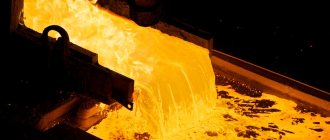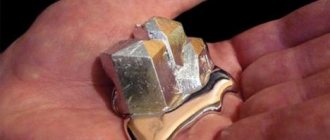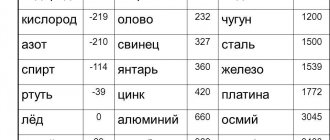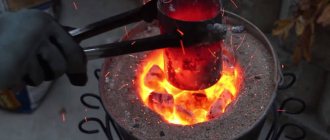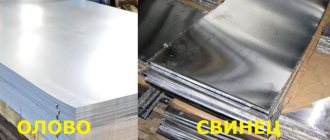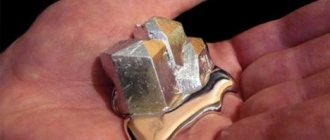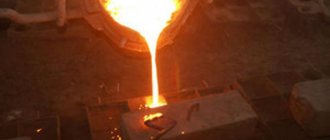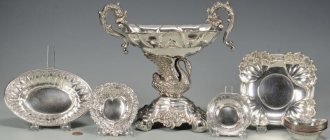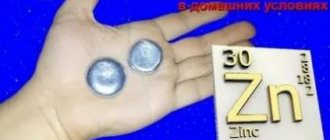Properties of glass
Besides the fact that glass has a melting point and that a wide variety of products can be made from this material, it has many other properties. The density of glass largely depends on its chemical composition; this indicator characterizes the ratio of volume to weight of the material. So, this indicator is the lowest for quartz glass.
Crystal, on the contrary, has the highest, which can exceed 3 g/cm3. The strength of this material also depends on the chemical composition, that is, how glass can maintain its integrity in products under the influence of external loads. During tension and compression, the influence of the chemical composition is almost the same. The hardness of the material is affected by the presence or absence of impurities and their quantitative indicator in a given specimen. The hardest is considered to be the one that contains a large amount of silica, namely quartz and borosilicate. In turn, the presence of lead oxides in the composition reduces the strength characteristics. As you know, the high melting point of glass allows you to change its appearance and, if necessary, obtain a completely different shape. But at low temperatures, which are considered normal for human life, glass is destroyed under stress, rather than deformed.
The fragility of glass products depends on the thickness of the material, as well as the shape. The easiest way to break it into fragments is flat glass. To increase this indicator, magnesium oxides and boric anhydride are added to the composition during the production of the material. The more heterogeneous the glass, the more likely it is that it will break under mechanical stress.
How to make glass from sand
Most likely, you know that sand is needed to make glass, and indeed, it is the most important ingredient. To make a glass product transparent, quartz sand without metal impurities is used, which gives the material colored shades.
To make glass you will need siliceous sand, otherwise called quartz.
Since quartz sand has a melting point of 2300⁰C, components are needed that will help reduce it in order to make the manufacturing process easier and more affordable. Such an ingredient was sodium carbonate or ordinary soda ash, thanks to which the smelting temperature was reduced by almost half.
Baking soda (sodium carbonate) lowers the temperature required to produce glass sheets.
Impact of temperature
The melting temperature of glass deserves special attention. Despite the fragility of the material, in order to transform it into a liquid state, it will need to be heated to high temperatures. As for ordinary glass, its melting point ranges from 425 to 600 °C; for quartz glass, this figure reaches 1000 °C. Due to its fragility and, accordingly, the complexity of making really large parts from glass, there was a need to create a material that could be more durable while maintaining other properties. And in 1936, organic glass went on sale. The melting point of plexiglass is low, only 160 °C, and at 200 °C the material reaches a boil. Plexiglas is used literally everywhere, since its transparency is the same as that of others, but in terms of impact resistance it is an order of magnitude higher.
Glass transition temperature of polymers
Below are the glass transition temperatures of some polymers (source: L. Nielsen, Mechanical properties of polymers and polymer compositions, translation by P. G. Babaevsky, M. - Publishing House "Chemistry", 1978):
Table 2. Glass transition of polymers
| Polymer | Tg, °C |
| Polyethylene | –120 (–130) |
| Isotactic polypropylene | –10 |
| Polyisobutylene | –70 (–73) |
| Atactic polystyrene | 100 (105) |
| Isotactic polystyrene | 100 |
| Polymethylacrylate | 3 (6) |
| Polyethyl acrylate | –24 |
| Polyzinc acrylate | 300 |
| Polymethyl methacrylate syndiotactic | 115 (205) |
| Isotactic polymethyl methacrylate | 45 (55) |
| Polyethyl methacrylate | 65 |
| Polyvinyl chloride | 87 (81) |
| Polycarbonate | 150 |
| Polyethylene terephthalate | 69 |
| Polyamide 6 (polycaproamide) | 50 (40) |
| Polyamide 6,6 (polyhexamethylene adipamide) | 50 (57) |
*Values less commonly found in the literature are indicated in parentheses.
Quartz glass
This type of glass is produced by melting high purity raw materials. Therefore, the answer to the question at what temperature quartz glass melts is 1000°C. This demonstrates the fact that this type of material is also the most heat-resistant, so if you put it in hot water in cold water, it will not crack. Thanks to this, quartz glass can be used at very high temperatures, because to bring it into a liquid state, the temperature must reach 1500 ° C.
There are two varieties of this glass - transparent and milky-matte quartz. In terms of their performance, they are almost identical, but differ in optical properties. The surface of quartz glass has a greater adsorption capacity not only for moisture, but also for some gases. It is also worth remembering that quartz must be protected from all kinds of contaminants, including greasy hand marks; such stains can be removed with ethanol, or acetone can be used as an option.
Melting glass
It is very easy to melt this material at home. You just need to purchase a special oven, which will cost about 7 thousand rubles. However, the expenses will quickly pay for themselves, because you will have practically no competitors.
The oven can work with almost any model of microwave. First you need to remove a special heating plate from there and warm up the stove.
Use a glass cutter to cut the glass into pieces. Cut out a piece of phase paper slightly larger than the intended finished product. We lay out the desired pattern on paper and place it on the bottom of the oven. Close the lid and turn on the microwave at highest power for 2 minutes.
When you see an orange glow inside the furnace, it means the glass has begun to melt. Now put on gloves and carefully check the condition of the product by opening the oven slightly. If it is not ready yet, continue baking, but no more than 5 minutes, as this may damage the oven.
Borosilicate glass
This type of glass contains a large amount of boron oxide, which explains its name. Thanks to the introduction of this substance into the composition, it can be much stronger than other types. The resistance to thermal shock of borosilicate glass can exceed that of lime glass by 5 times. Other indicators are related to the chemical resistance of glass and allow its active use in electrical engineering. To soften this type of material described, it is necessary to heat it to a temperature of 585 ° C.
Melting - glass - Great Encyclopedia of Oil and Gas, article, page 1
Melting - glass
Page 1
Glass melting is carried out in induction electric furnaces, called vacuum-atmospheric furnaces. In such furnaces, a graphite crucible with rock crystal, in the center of which a punch is placed, is installed in a furnace on the casing of which an induction spiral is wound. High frequency currents cause rock crystal to melt. To remove gases, a high vacuum is maintained in the furnace. At the end of melting, the pressure in the furnace rises to atmospheric pressure. [1]
Glass melting is carried out in reverberatory furnaces, using longitudinal annular or transverse heating. [2]
Glass melting is carried out in induction electric furnaces. [3]
When melting glass, high temperatures are necessary because they lower the viscosity, which facilitates the reaction and helps remove gas. [5]
Depending on the scale of production, two methods are used
glass melts In small quantities glass is always melted in pots, which are large crucibles; Several such crucibles are usually heated in one furnace. [7]
The use of quartz glass bars for lining glass melting baths when melting borosilicate glasses [33], as well as crucibles for melting special high-quality types of glass, has a great effect. [9]
In the glass-ceramics industry, high-risk areas are those in which glass melting and ceramic firing furnaces are located; Particularly dangerous are bevel shops. [10]
Agricola in his German index Glasgallen is the glass foam formed when glass is melted and contains mainly sodium sulfate and calcium sulfate. [eleven]
In the production of building materials, drying and firing of ceramic products and bricks, firing of clinker and lime, and glass melting are widespread.
. For these purposes, gas furnaces are used, which differ in operating principle and design. According to their technological purpose, furnaces in the building materials industry can be divided into the following main groups: furnaces for ceramic production, furnaces for the production of binders, furnaces for glass production. Below are the most common gas-fired ovens in the building materials industry. [13]
Thermal processes at enterprises in the building materials industry are: drying of ceramic products; firing of bricks, ceramic products, clinker, lime; melting glass, slag, marls, expanding expanded clay, steaming reinforced concrete and silicate products and others. [14]
To obtain a blue or bluish-green color, it is necessary to add 3–5% copper oxide and sometimes small amounts (0–05%) cobalt oxide into the mixture. Melting of copper glass should be carried out in an oxidizing atmosphere in the furnace chamber, since in the presence of a reducing atmosphere and in the presence of organic substances, red-brown enamel can be obtained. Copper ruby, an enamel colored red, is obtained by reducing the oxygen compounds of copper during the smelting process. Used for enameling jewelry. The difficulty of obtaining a constant color of enamel containing copper oxide as a dye prevents its widespread use for the production of colored enamels. [15]
Pages: 1 2
www.ngpedia.ru
DIY making
For independent creativity, first of all, you need a suitable workplace in which you should equip a powerful hood. Melting glass at home requires a constant supply of fresh air. In the warm season, a plot in the country house or in the courtyard of the house is suitable.
Before working in an enclosed area, remove flammable materials and flammable items from the area. Propane and oxygen-propane burners operate from cylinders, which must be located at a distance of at least five meters from the workbench. The oxygen concentrator is safe to use , but is much more expensive than its analogues. Gas equipment should only be installed by a specialist, subject to all safety precautions.
Required Tools
To work with such a fragile material as glass, various materials are used, without which high-quality performance is impossible:
- The burner is the main tool needed to melt glass.
- Mandrels or knitting needles are rods around the tips of which molten material is wound.
- The ceramic blanket replaces industrial ovens for gradual and uniform cooling of finished products.
- The coating or separator is used to easily and quickly remove the bead from the mandrel.
- Tweezers and spatulas are graphite. With the help of these devices, the desired shape is given to the product.
- Glass lampwork sticks come in a variety of colors and thicknesses. Sold by piece or by weight. It is more profitable to buy the equivalent weight.
- A respiratory mask is needed to protect yourself from the harmful effects of combustion products.
- Safety glasses.
Working with glass at home, melting glass.
It won't work with a soldering iron. noona small burner. 300 rubles.
No, you won’t be able to fuse it with a soldering iron - it only heats a section of glass, but to weld glass you need to heat the area around it. At home, glass can be welded using the so-called. Fevki - blowing air into burning gasoline vapors. But this is a very dangerous activity. However, it may not be possible to weld thick-walled parts even with fevka; it is better to use the so-called. Laboratory glass - it has a lower melting point.
https://fashiony.ru/page.php?id_n=57853 and here
touch.otvet.mail.ru
How to melt glass? What is the melting temperature of glass?
1
- Auto and motorcycle Motorsport
- Car insurance
- Cars
- Service, Maintenance, Tuning
- Service, care and repair
- Choosing a car, motorcycle
- Traffic police, Training, Rights
- Registration of auto-moto transactions
- Other Auto Themes
- Arts and entertainment
woprosi.ru
